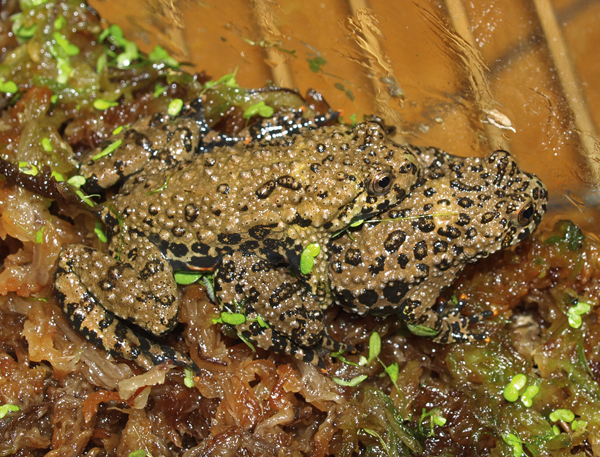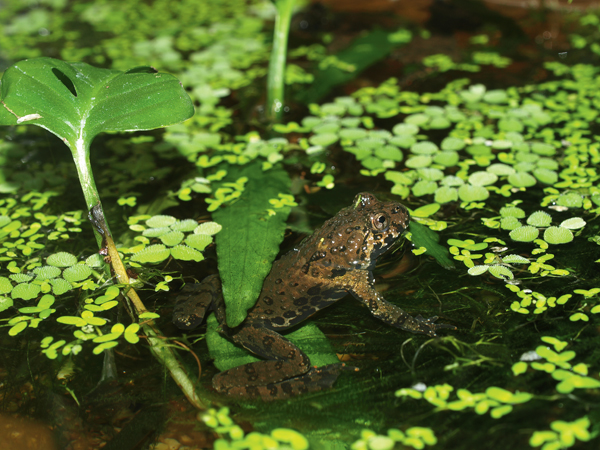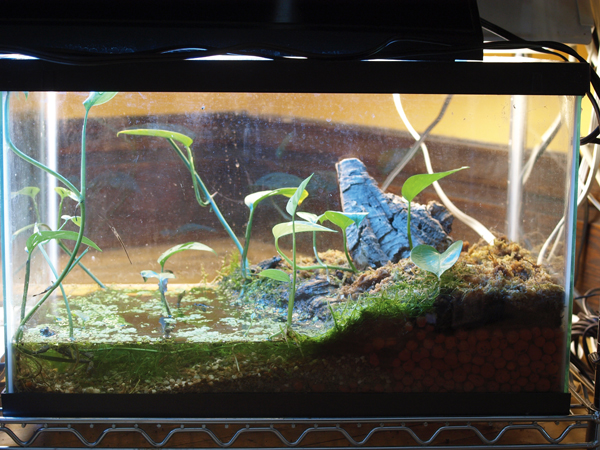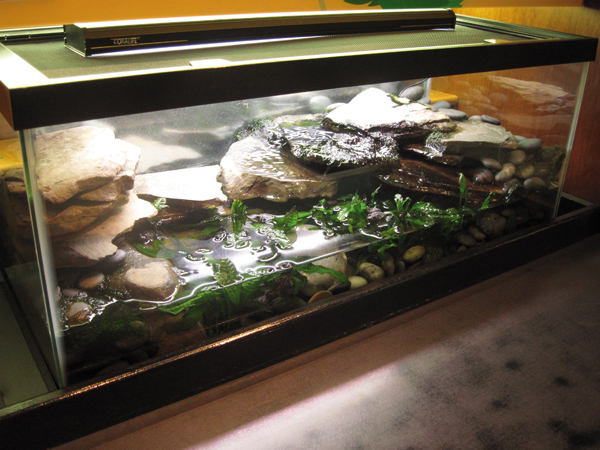Some hobbyists have a tendency to look down upon fire-bellied toads. They’re for beginners, they say, a cheap alternative to more exotic species
Some hobbyists have a tendency to look down upon fire-bellied toads. They’re for beginners, they say, a cheap alternative to more exotic species such as dart frogs and tree frogs with price tags several times that of an ordinary Bombina orientalis. Its overly familiar presence gives the species a sense of being commonplace, a dull and everyday amphibian, uninteresting but for novice keepers. Indeed, fire-bellied toads fall second only to African dwarf aquatic frogs (Hymenochirus curtipes) as the most heavily traded pet amphibian in North America, with hundreds of thousands bought and sold each year in the United States.
At one point I shared this mindset. Then, after many years of maintaining a large and diverse collection of animals, I scaled down, cutting back to just a few terrariums. Among them was a 10-gallon tank to which I added a group of fire-bellied toads, renewing the joy that came with keeping this species in captivity. Displayed in my living room, the terrarium brightly lit and planted, I found watching the fire-bellies as enjoyable as any of the more exotic species I had cared for previously. I realized they are popular for good reason.
Toxic Appeal
It’s true, fire-bellied toads are ideal first pet amphibians. They are the leopard geckos or corn snakes of the frog world, hardy and colorful and ever-forgiving for mistakes. But they also display a number of qualities that should appeal to more experienced keepers.
For one, unlike most amphibians, fire-bellied toads are active during the day. Their diurnal tendencies allow keepers to easily observe their behavior, which includes not only the typical frog fare of sitting around and waiting for food, but also aggressive strongholds by males while they grasp seemingly anything that moves, their companions uttering squeaky distress calls and splashing around in embrace.

devin edmonds
Bombina orientalis is the most commonly available fire-bellied toad
.
Fire-bellied toads are able to move around freely during the day because glands in their skin secrete a toxin that makes them unappetizing to predators. This is also the reason for their fire bellies—the red, orange or yellow coloration of the various Bombina species that warns of their poisonous nature. They are one of a handful of amphibians known to engage in what’s called the “unken reflex,” whereby they show off their bright underside when they feel threatened by lifting their legs and arms in the air and arching the back, or in extreme cases flipping the body over entirely so all that is visible is the bright ventral coloration.
Don’t worry, though, fire-bellied toads are not dangerous to people unless ingested. So don’t eat your pets. Frankly, it’s best to not handle them anyway, as soap residues and oils on human skin can irritate a toad’s skin. If you need to move them around, such as when you’re cleaning the terrarium, coax toads into a moist aquarium net or plastic container. And always wash your hands after working with them or their enclosures, to be sure you don’t accidentally get any of their skin secretions into your mouth, nose or eyes.
Fire-Belly Diversity
Bombina orientalis is the most commonly available fire-bellied toad. The species is native to Korea, northeast China and a sliver of southeast Russia, with nearly all in the U.S. originating abroad and imported in the form of wild-caught or farmed stock. While the typical B. orientalis is grass green and black above, individuals can vary in dorsal color to a less-attractive brown or bronze. Luckily, even the ugliest B. orientalis have a vibrant red-orange underneath.
Another species, the yellow-bellied toad (B. variegata), is at times available but typically only through specialty pet stores and herp dealers. It commands a higher price, especially the albino form which is creamy white with a pattern of pasty yellow on the belly (the normal coloration is brown above and golden below). Yellow-bellied toads are native to Europe, ranging from Greece and Romania west to Germany and France, where they are more widely kept than in the United States.
Also native to Europe is B. bombina, which differs most obviously from B. orientalis and B. variegata by belly colors with a greater degree of black-brown than orange. All three species grow to at most near 2 inches in length, the majority staying smaller.

devin edmonds
Fire-bellied toads are hardy pets that display a number of appealing qualities, including bright colors, diurnal activity and interesting behaviors.
One last species is also available on occasion: the giant fire-bellied toad (B. maxima). As the name implies, it is larger than the other species by half an inch or more. The mainly tan-gray dorsum is covered in bulbous warts, more so than the mildly granular skin of the other species. The giant fire-bellied toad is native to extreme northern Vietnam and southern China, and captive-bred stock of this big and warty fire belly is available every so often, usually through private breeders or specialty herp dealers.
All of these toads inhabit marshy wetlands and swampy habitats, close to water and often in or near forests. In captivity their care is essentially the same, though due to their hardy nature there are many different ways to care for them. So long as you maintain a clean environment, the right range of temperatures and provide a varied diet, fire-bellied toads should live for 10 years or more in captivity (and exceeding 20 years is not unheard of).
A Healthy Start
While a pet store may be the easiest place to locate fire-bellied toads, consider first contacting your local herpetological society to ask if anyone in your area has had recent breeding success. Captive-bred stock direct from the source is almost always guaranteed to be in better condition than the more commonly available toads caught in the wild and shipped around the world to pet stores. If there are no captive-bred options, then take care while picking your toads (I write “toads” because they are more enjoyable to keep in groups, although a single toad can be kept happily alone).
Look at the enclosure the toads are in. Is it clean? Are there sick or unhealthy animals inside? Are the toads housed with other species? Fire-bellied toads are frequently kept at stores with various types of frogs, newts, crabs or other semi-aquatic animals, but this is a risky situation that can result in stress and foreign pathogens being exchanged between species originating from different places. This is not to mention the potential physical trauma from the toads attempting to eat their cagemates—they are aggressive feeders and won’t hesitate to bite the tail or leg of a newt! If the conditions at the store are not up to par, find your toads elsewhere.
Healthy fire-bellied toads should be plump, with the sides of the body slightly rounded. They should not be ballooning out with bloat, or emaciated and sunken in. Also look for excessive sloughing skin. Healthy toads shed skin regularly, which they will also consume, but it’s a good idea to pass up toads that exhibit dead, gray skin hanging off of them, which could be a symptom of disease. Look carefully, too, for sores and wounds, which often result from trauma, infection or injuries that occur in the cramped conditions in which wild-caught fire-bellied toads are transported to the U.S.
Lastly, try to observe the behavior of the toads. While fire-bellies are bold amphibians, they should still startle when a hand enters the cage. Lethargic and unresponsive toads may outwardly appear healthy but could be suffering from an ailment that you can’t see otherwise.
The Toad Abode
A setup for fire-bellied toads can be as simple or complex as you like, keeping in mind the semi-aquatic nature of the toads and their preference to float in shallow water with their toes, if only just barely, in contact with something solid beneath.

devin edmonds
A standard setup for Bombina incorporates a land area that slopes down into an equally sized water area.
The simplest approach is to fill an aquarium with 1 or 2 inches of tap water—treated a day in advance with an aquarium additive to neutralize chlorine and chloramines—and float a large slab of cork bark on the surface. Alternatively, several large rocks (granite, quarts or slate) can be arranged to protrude from the water as a land area. No substrate is needed, and the land should be about equal in surface area to water. It’s important in these types of simple systems to change the water regularly, as often as two or three times a week, and to remove waste such as feces and dead feeder insects immediately.
An alternative approach is to submerge a shallow water container into a substrate of coconut husk fiber or other soil-like substrate. The water container should cover about half of the bottom of the terrarium. Artificial plants and pieces of cork bark can be placed on top of the coconut husk fiber for cover. Change the water dish daily and ensure the substrate stays moist by adding a little water to it once or twice per week, though never allow it to become waterlogged or soggy.

DEVIN EDMONDS
A setup for fire-bellied toads can be very basic, or a bit fancier, such as this one.
Fire-bellied toads do not require a large enclosure. A standard 10-gallon aquarium provides enough room for up to three adults, while a group of six or more can be maintained in a 20-gallon tank. Always use a tight-fitting screen cover to prevent escapes. Room temperature is perfect for keeping fire-bellies, with the ideal temperature range between 65 and 78 degrees Fahrenheit. Hot conditions exceeding 82 degrees are dangerous, but cool temperatures down to 50 degrees do not present a problem. Use a thermometer to monitor the temperature.
Humidity is less important than temperature, with normal household levels of 30 percent or more sufficient. In especially dry conditions, the enclosure can be sprayed with water daily to keep the environment moist and provide temporary increases in humidity similar to what the toads would experience after rain in the wild.
The Planted Tank
Simple setups for fire-bellied toads are practical, but toads can also be displayed in attractive semi-aquatic planted aquariums. To create one, slope a substrate of gravel toward one side. Several rocks can be used to hold the gravel in place, while the aquarium is filled with enough water to just barely reach below the high point of the sloped gravel.
Live Java moss (Vesicularia dubyanacan) placed along the shoreline, given time, moisture and light, will grow and help hold the gravel in place. Pothos (Epipremnum aureum), heart-leafed philodendron (Philodendron hederaceum) and other hardy houseplants that can grow directly in gravel can be planted on land, while Cryptocorine species or parrot feather (Myriophyllum aquaticum) work well in the water. Anubias species and Java fern (Microsorum pteropus) are also good aquatic choices, tied with fishing line onto submerged pieces of driftwood or rocks. In a planted semi-aquatic aquarium, the water depth can be increased to half a foot or more to accommodate plants; the vegetation will provide footholds for the toads in deep water.
The addition of live plants will not only spruce up an enclosure, but in time plants help to maintain water quality and produce a stable environment where partial water changes may only be needed a couple times per month. In order to include live plants, however, it is important that sufficient lighting is provided. Fire-bellied toads themselves do not require any sort of special lighting, but if you use plants, be sure to place at least two or more standard T8 fluorescent tubes over the aquarium. Lights with a natural color temperature of between 5000 and 65000 Kelvin look best.
Aggressive Appetites
Despite the small size and seemingly cute appearance of fire-bellied toads, they are also fierce predators with big appetites. Movement triggers them to lunge at just about any potential food item wandering past. In nature, Bombina have been documented feeding on a variety of both terrestrial and aquatic invertebrates, including flies, worms, slugs, snails, mites, springtails, water beetles, backswimmers and amphipods.
It is important to provide pet fire-bellied toads with a variety of food items. Crickets are readily available and can form the bulk of the diet. Offer two to six crickets per toad once or twice a week. Although hungry toads can manage to cram adult crickets into their mouths, it is safest to feed smaller ones that are no longer than the width of the toad’s head (about half an inch or so). Lightly coat crickets in a high-quality powdered nutritional supplement before introducing them into the enclosure to ensure nutritional requirements are met.
Other types of prey should be offered instead of crickets a few times per month. Earthworms can be cut into pieces and placed in a shallow dish, such as the lid of a small jar, on land. So long as the pieces of worm are still wriggling the toads will eat them. Wax worms and other soft-bodied insect larvae can also be offered. Some toads will feed on Tubifex worms and black worms, which are available in the fish department of pet stores. These foods are best placed on land rather than in the water as you would for aquarium fish.
Fire-bellied toads will also eat small guppies, ghost shrimp and snails should these aquatic creatures venture into shallow areas near land. Juvenile toads can be fed flightless fruit flies, springtails and newly hatched crickets.
Bombina Breeding Techniques
With cheap imported fire-bellied toads dominating the pet trade, there is little financial incentive to breed them in captivity. Still, it can provide an interesting opportunity to observe the entire life cycle of an amphibian. Of the four available Bombina species, it is the most commonly available, B. orientalis, that is easiest to persuade into reproducing.
Try to have a group that consists of at least several male/female pairs. Having extra males, as many as three to every single female, may also help promote breeding. Males can be distinguished from females by the presence of dark nuptial pads, but these are only visible when the toads are ready to reproduce. Males also have slightly more muscular forearms, but the best way to differentiate the sexes is to listen. If you observe a calling toad, there is no doubt it is a male, although female toads can emit less-boisterous distress calls. The call of a male is loud and rhythmic.
In nature, fire-bellied toads reproduce following a period of winter hibernation, and in captivity seasonal changes in temperature will encourage breeding activity. If your goal is to breed your toads, keep them in a room that naturally experiences changes in temperature during different times of the year, such as a basement or enclosed porch. Maintain their environment near 60 degrees or lower for a month or so.
When temperatures start to warm up, provide frequent water changes and feed heavily. Big water changes imitate the conditions of spring rains, which is when wild fire-bellied toads start to breed in nature. If all goes well, females will swell with eggs and pairs will engage in amplexus. A female can produce new eggs every two to three weeks.
Spawning usually takes place at night and little brownish eggs numbering anywhere from 30 to more than 100 are laid in the water, on aquatic vegetation or other submerged items. Strips of plastic bags placed in the water have also been used as oviposition sites in captivity. If the eggs are fertile, within a day or two you will notice the ovum splitting and tadpoles developing. At this point, remove the eggs and any objects they were laid on to a separate aquarium. Tadpoles should emerge from the egg jelly three to 10 days after being laid and take one to five months to complete metamorphosis.
Tadpoles will grow to slightly over an inch in length before developing arms and leaving the water. They are not picky eaters and can be raised on aquarium fish flake foods. When front arms develop, reduce their water depth to an inch or so, and provide access to land. Juvenile toads are not as attractive as adults, being predominantly brown in color and about three-quarters of an inch long at metamorphosis. It takes at least one full year for maturity to be reached.
Many people who have bred fire-bellied toads report that the bright ventral coloration of captive-bred toads is not as intense as that of those in the wild. For this reason, consider providing a dietary supplement that provides carotenoids to juvenile toads, and feed tadpoles a carotenoid-rich fish flake. Carotenoids give amphibians the colors yellow, orange and red, and a captive diet deficient in them may contribute to dull-colored animals.
Fire-bellied toads are hardy pets that display a number of appealing qualities, including bright colors, diurnal activity and interesting behaviors. They are common, but with good reason. The most important part of their care is providing the right environment. Top that off with a varied diet, and you will have a long-lived group of toads to enjoy watching for years.
Devin Edmonds has kept frogs and toads since childhood, and he created the popular website amphibiancare.com. He holds a degree in zoology from the University of Wisconsin-Madison and has authored three books about amphibian husbandry. Currently, he lives in Andasibe, Madagascar, where, with the community-run conservation organization Mitsinjo, he manages a breeding facility for threatened frog species.


